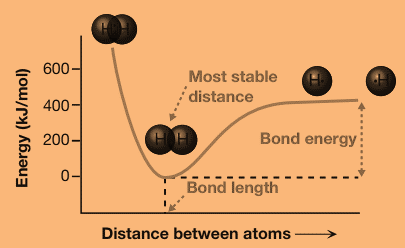
Concept explainers
(a)
Interpretation:
Out of the two distances between two nitrogen atoms, 50 pm or 75 pm, it is to be determined which one represents higher energy.
Concept introduction:
The energy of the molecule depends on the distance between the two atoms. At a certain distance, called the bond length, the energy reaches a minimum. As the distance between the two atoms increases, the energy of the molecule increases and slowly approaches a constant value as the distance increases to infinity. At distances shorter than the bond length, the energy increases very rapidly.

(b)
Interpretation:
Out of the two distances between two nitrogen atoms, 75 pm or 110 pm, it is to be determined which one represents higher energy.
Concept introduction:
The energy of the molecule depends on the distance between the two atoms. At a certain distance, called the bond length, the energy reaches a minimum. As the distance between the two atoms increases, the energy of the molecule increases and slowly approaches a constant value as the distance increases to infinity. At distances shorter than the bond length, the energy increases very rapidly.

(c)
Interpretation:
Out of the two distances between two nitrogen atoms, 110 pm or 150 pm, it is to be determined which one represents higher energy.
Concept introduction:
The energy of the molecule depends on the distance between the two atoms. At a certain distance, called the bond length, the energy reaches a minimum. As the distance between the two atoms increases, the energy of the molecule increases and slowly approaches a constant value as the distance increases to infinity. At distances shorter than the bond length, the energy increases very rapidly.

(d)
Interpretation:
Out of the two distances between two nitrogen atoms, 150 pm or 160 pm, it is to be determined which one represents higher energy.
Concept introduction:
The energy of the molecule depends on the distance between the two atoms. At a certain distance, called the bond length, the energy reaches a minimum. As the distance between the two atoms increases, the energy of the molecule increases and slowly approaches a constant value as the distance increases to infinity. At distances shorter than the bond length, the energy increases very rapidly.

Want to see the full answer?
Check out a sample textbook solution
Chapter 1 Solutions
EBK ORGANIC CHEMISTRY: PRINCIPLES AND M
- presented by Morallen Lig Intermine the hand product for the given mution by adding atoms, bonds, nonhonding diarion panda скуль Step 3: Comp the draw the product Step 2: Agama workup Compithe 429 ملولةarrow_forwardReaction A 0,0arrow_forwardpresented by Morillon Leaning Predict the organic product for the min кусур HSC Adithane carved arnown to come than that to the condon slchroruis in acid in in aquishri with ноюarrow_forward
- 6.15PM Sun Mar 30 K Draw the major product of this reaction. Include any relevant stereochemistry. Ignore inorganic byproducts. Problem 1 of O H [PhзPCH2CH3]*C|¯ NaH Drawing > Q Atoms, Bonds and Draw or tap a nearrow_forward8:17 PM Sun Mar 30 Draw the major product of this reaction. Ignore inorganic byproducts. HSCH2CH2CH2SH, BF3 Probler Drawing Ato Bonds Clarrow_forwardpresented by Mr L How the coprion. (Il Done in no wraction, dew the starting redential) доarrow_forward
- 8:16 PM Sun Mar 30 K Draw the major product of this reaction. Ignore inorganic byproducts. Proble 1. CH3MgBr 2. H3O+ F Drawingarrow_forwardо но оarrow_forwardName the major organic product of the following action of 4-chloro-4-methyl-1-pentanol in neutral pollution 10+ Now the product. The product has a molecular formula f b. In a singly hain, the starting, material again converts into a secule with the molecular kormula CIO. but with comply Draw the major organic structure inhalationarrow_forward
- Macmillan Learning Alcohols can be oxidized by chromic acid derivatives. One such reagent is pyridinium chlorochromate, (C,H,NH*)(CICTO3), commonly known as PCC. Draw the proposed (neutral) intermediate and the organic product in the oxidation of 1-butanol by PCC when carried out in an anhydrous solvent such as CH₂C₁₂. PCC Intermediate OH CH2Cl2 Draw the intermediate. Select Draw Templates More с H Cr о Product Draw the product. Erase Select Draw Templates More H о Erasearrow_forwardIf I have 1-bromopropene, to obtain compound A, I have to add NaOH and another compound. Indicate which compound that would be. A C6H5 CH3arrow_forwardProvide the reagents for the following reactions.arrow_forward
 Introduction to General, Organic and BiochemistryChemistryISBN:9781285869759Author:Frederick A. Bettelheim, William H. Brown, Mary K. Campbell, Shawn O. Farrell, Omar TorresPublisher:Cengage Learning
Introduction to General, Organic and BiochemistryChemistryISBN:9781285869759Author:Frederick A. Bettelheim, William H. Brown, Mary K. Campbell, Shawn O. Farrell, Omar TorresPublisher:Cengage Learning Principles of Modern ChemistryChemistryISBN:9781305079113Author:David W. Oxtoby, H. Pat Gillis, Laurie J. ButlerPublisher:Cengage Learning
Principles of Modern ChemistryChemistryISBN:9781305079113Author:David W. Oxtoby, H. Pat Gillis, Laurie J. ButlerPublisher:Cengage Learning

